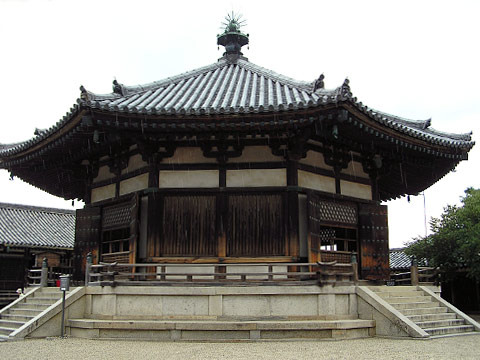|
||
 |
||

Houryuuji
Touin *Yumedono 法隆寺東院夢殿
(Nara)
(C)2001 Japanese Architecture and Art Net Users System. No reproduction or republication without written permission.
掲載のテキスト・写真・イラストなど、全てのコンテンツの無断複製・転載を禁じます。
|
||||||
| hakkakudou 八角堂 | ||||||
| KEY WORD : architecture / buildings & structures | ||||||
| Also
called *hakkaku endou 八角円堂.
An octagonal hall. There are six extant, five of which are designated as national
treasures and the other as an important cultural property. All are small structures.
Five are erected on stone podii with access by steps on one two, three, or four
sides. The one at Kouryuuji Keikyuuin Hondou 広隆寺桂宮院本堂, (Kamakura period),
has simple plank flooring under which is a white, plaster-covered, turtle-back-shaped
mound called *kamebara
亀腹. The oldest octagonal hall is the Houryuuji Touin *Yumedono
法隆寺東院夢殿 in Nara. Although the original building was relatively simple and well
proportioned, it underwent considerable repair and remodeling in 1230. The only other octagonal hall remaining from the Nara period is
the one at Eizanji 栄山寺 (757-64). Two clearly dated octagonal halls remain
from the 13c. They are Koufukuji *Hokuendou
興福寺北円堂 (1210) in Nara, and Houryuuji *Saiendou
西円堂 (1250). The beams and pillars in octagonal halls were also made octagonal in
cross section. These buildings were erected by patrons dedicated to a specific
Buddhist deity or saint to whom they wished to pay homage or as a way to gain
special merit in the hereafter. |
||||||
 Houryuuji
Touin *Yumedono 法隆寺東院夢殿
(Nara)
|
||||||
| REFERENCES: | ||||||
| *endou 円堂, *rokkaku endou 六角円堂 | ||||||
| EXTERNAL LINKS: | ||||||
| NOTES: | ||||||
(C)2001 Japanese Architecture and Art Net Users System. No reproduction or republication without written permission. 掲載のテキスト・写真・イラストなど、全てのコンテンツの無断複製・転載を禁じます。 |
||||||